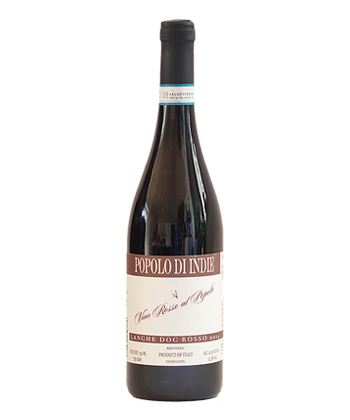I recently asked VinePair’s co-founder, Adam Teeter, for a few new restaurant ideas. At the top of his list was the recently opened Fiaschetteria Pistoia on New York’s Lower East Side. When I went last Friday, I immediately understood why.
After we sat down in the cozy but lively space, a waitress came by and parked a milk bottle rack holding a dozen wine bottles on our table, whites on one side, reds on the other. “Here’s the wine list,” she announced. I knew we were in for a fun evening.
Each bottle had a tag hanging from its neck with the essentials — region, appellation, grapes, price. For a deeper dive, you could pick up the bottles and study the labels.
Among the reds there were a few from Tuscany (the restaurant’s roots are in the city of Pistoia near Florence), one from Abruzzo, and another from Piedmont, or Piemonte. The latter immediately drew my attention.

I ordered the 2016 Langhe Rosso called “Vino Rosso al Popolo,” bottled under the Popolo di Indi label. The wine is from the lesser-known Langhe area of Piedmont in Italy’s north and is made by a producer there for the U.S. importer, Indie Wineries, which specializes in small producers, many using organic or biodynamic methods.
It turns out that the Vino Rosso is a blend of Piedmont’s top three red varieties — 55 percent Nebbiolo, 30 percent Barbera, and 15 percent Dolcetto. As the Indie Wineries website describes it, “the Barbera brings the acidity and bright fruit, the Nebbiolo brings the tannins and the aromatics, and the Dolcetto brings the softness and rounds out the blend.”
The description is pretty accurate, and it all adds up to a relatively light (12.5 percent alcohol), refreshing, and interesting blend that benefits from a slight chill and is a versatile food wine — we all had the hand-cut pastas as main courses, including a duck ragu, a deliciously simple spaghetti with pecorino and pepper, and one with a dark, concentrated tomato sauce that infused itself in the pasta.
With its lively acidity, earthiness, fresh berry notes (mainly raspberry and blueberry), and a suggestion of baking spices, the wine was a perfect counterpoint, holding its own with the intensity of the food but also lightening things up. The freshness is maintained by aging in stainless steel, with no exposure to oak.
While the $38 restaurant price we paid is a good deal for a wine of this quality, the average retail price is, remarkably, only about $15. There is also an excellent white, Bianco del Popolo, made from the Cortese grape, that drinks better than many Gavis and is even more of a bargain. Both appear to have decent availability.
I have no doubt I’ll be returning to Fiaschetteria Pistoia — and its wines.
